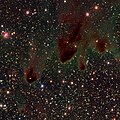Gum Nebula
You can help expand this article with text translated from the corresponding article in Italian. (October 2015) Click [show] for important translation instructions.
|
| Supernova remnant | |
|---|---|
 The Gum Nebula in H-alpha | |
| Observation data: J2000.0 epoch | |
| Right ascension | 08h 00m |
| Declination | −43° 00′ |
| Distance | 1470 ly (450 pc) |
| Apparent magnitude (V) | +12 (infrared only) |
| Apparent diameter | 30° |
| Constellation | Vela, Puppis |
| Physical characteristics | |
| Absolute magnitude (V) | 3.73 (infrared) |
| Designations | Gum 12 |
The Gum Nebula (Gum 12) is an emission nebula that extends across 36° in the southern constellations Vela and Puppis. It lies approximately 450 parsecs from the Earth.[1] Hard to distinguish, it was widely believed to be the greatly expanded (and still expanding) remains of a supernova that took place about a million years ago. More recent research suggests it may be an evolved H II region. It contains the 11,000-year-old Vela Supernova Remnant, along with the Vela Pulsar.
The Gum Nebula contains about 32 cometary globules.[2] These dense cloud cores are subject to such strong radiation from O-type stars γ2 Vel and ζ Pup and formerly the progenitor of the Vela Supernova Remnant that the cloud cores evaporate away from the hot stars into comet-like shapes. Like ordinary Bok globules, cometary globules are believed to be associated with star formation.[3] A notable object inside one of these cometary globules is the Herbig-Haro object HH 46/47.
The main ionizing sources are the Vela OB2 association (including Gamma Velorum cluster and the P Puppis cluster), Zeta Puppis and the OB association Trumpler 10.[4][5] The star cluster NGC 2547 formed 100 pc more distant than Vela OB2 and is an interloper.[5] The Vela OB2 association is surrounded by the so-called "IRAS Vela Shell", located in the south of the Gum Nebula. The star clusters NGC 2547, Trumpler 10, NGC 2451B, Collinder 135 and Collinder 140 all have similar ages of about 30 Myrs. It is suggested that a few stars exploded in supernovae about 30 Myrs ago in the center of the Gum Nebula and triggered the formation of stars in the region.[6]
It is named after its discoverer, the Australian astronomer Colin Stanley Gum (1924–1960). Gum had published his findings in 1955 in a work called A study of diffuse southern H-alpha nebulae (see Gum catalog). He also published the discovery of the Gum Nebula in 1952 in the journal The Observatory. The observations were made with the Commonwealth Observatory.[7]
The Gum nebula was photographed during Apollo 16 while the command module was in the double umbra of the Sun and Earth, using high-speed Kodak film.[8]
Popular culture
[edit]The Gum Nebula is explored by the crew of the Starship Titan in the Star Trek novel Orion's Hounds.[9]
Gallery
[edit]-
Clouds near the center of the Gum Nebula
-
Cometary Nebulae 30, 31 and 38 in the Gum Nebula. It also contains HH 120.
-
Vela OB2 with its brightest star Gamma2 Velorum is located in the Gum Nebula. The image also contains the smaller star cluster NGC 2547 in the lower left part.
-
One of 4 images of the Gum Nebula photographed by Apollo 16 in 1972. AS16-127-20024.
-
The Gum Nebula is visible as the faint large red nebula in this image.
See also
[edit]References
[edit]- ^ Graham, J.A., 1986. Objects associated with low-mass star formation in the Gum nebula. The Astrophysical Journal, 302, pp.352-362.
- ^ Zealey, W. J., Z. Ninkov, E. Rice, M. Hartley, & S. B. Tritton. 1983, ApL, 23, 119.
- ^ Reipurth, B. 1983, A&A, 117, 183. Star formation in BOK globules and low-mass clouds. "I - The cometary globules in the GUM Nebula."
- ^ Kim, Jinyoung Serena; Walter, Frederick M.; Wolk, Scott J. (2005-03-01). "Low-Mass Star Formation in the Gum Nebula: The CG 30/31/38 Complex". The Astronomical Journal. 129: 1564–1579. arXiv:astro-ph/0502285. Bibcode:2005AJ....129.1564K. doi:10.1086/428002. ISSN 0004-6256.
- ^ a b Armstrong, Joseph J.; Wright, Nicholas J.; Jeffries, R. D.; Jackson, R. J.; Cantat-Gaudin, Tristan (2022-12-01). "The structure and 3D kinematics of vela OB2". Monthly Notices of the Royal Astronomical Society. 517: 5704–5720. arXiv:2208.05277. Bibcode:2022MNRAS.517.5704A. doi:10.1093/mnras/stac3101. ISSN 0035-8711.
- ^ Cantat-Gaudin, T.; Mapelli, M.; Balaguer-Núñez, L.; Jordi, C.; Sacco, G.; Vallenari, A. (January 2019). "A ring in a shell: the large-scale 6D structure of the Vela OB2 complex". Astronomy & Astrophysics. 621: A115. arXiv:1808.00573. Bibcode:2019A&A...621A.115C. doi:10.1051/0004-6361/201834003. ISSN 0004-6361. S2CID 119071750.
- ^ Gum, C. S. (1952-08-01). "A large H II region at galactic longitude 226 deg". The Observatory. 72: 151–154. Bibcode:1952Obs....72..151G. ISSN 0029-7704.
- ^ Apollo 16 Preliminary Science Report (NASA SP-315), 1972. Chapter 31, Astronomical Photography, Part A, Gum Nebula, Glactic Cluster, and Zodiacal Light Photography, by R. D. Mercer, L. Dunkelman, and Thomas K. Mattingly.
- ^ Bennett, Christopher (2005-12-27). Orion's Hounds. Pocket Books. ISBN 141650950X.
External links
[edit]- Gum Nebula on WikiSky: DSS2, SDSS, GALEX, IRAS, Hydrogen α, X-Ray, Astrophoto, Sky Map, Articles and images
- APOD: Gum Nebula, with mouse over (2009.08.22)
- Galaxy Map: Entry for Gum 12 in the Gum Catalog Archived 2013-07-16 at the Wayback Machine
- Galaxy Map: Detail chart for the Gould Belt (showing the location of Gum 12 relative to the Sun)
- Encyclopedia of Science: Entry for the Gum Nebula (erroneously called Gum 56)
- SouthernSkyPhoto.com





